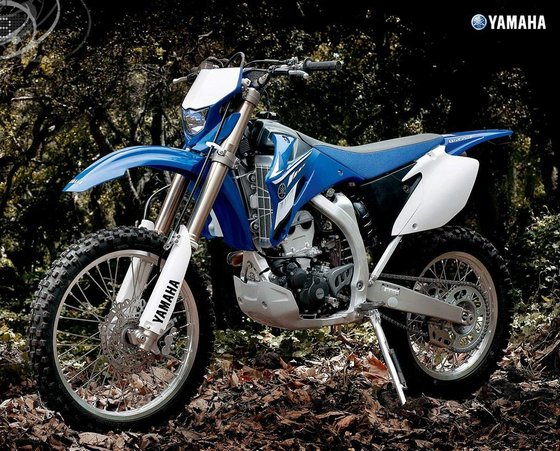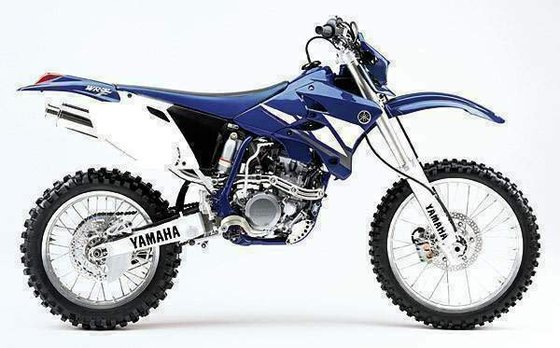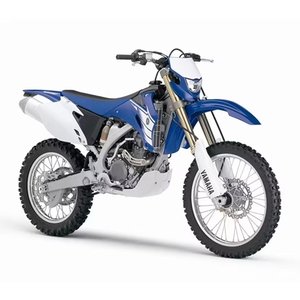Yamaha WR 250 F (2007–2010): A Trailblazer Built for Balance and Endurance

Introduction
The Yamaha WR 250 F, produced from 2007 to 2010, remains a standout in the enduro motorcycle segment. Designed to bridge the gap between motocross aggression and trail-riding finesse, this generation of the WR250F carved its niche as a lightweight, versatile machine capable of tackling everything from tight woods to open desert terrain. Yamaha’s engineering ethos here was clear: deliver a bike that prioritizes rider comfort, mechanical reliability, and adaptable performance. Having spent time aboard this machine, it’s evident that the WR250F isn’t just a motorcycle—it’s a partner for riders who demand precision and endurance.
Riding Experience: Where the WR250F Shines
The Heartbeat of the Trail
At the core of the WR250F is a 249cc liquid-cooled, four-stroke engine with a DOHC 5-valve configuration. What sets this powerplant apart is its titanium valves—40% lighter than steel equivalents—which reduce reciprocating mass and allow the engine to rev freely. The camshafts and ECU are tuned for enduro-specific low-to-midrange torque, making it less peaky than its YZ250F motocross cousin.
On the trail, this translates to smooth, tractable power that’s forgiving on slippery climbs yet responsive enough to loft the front wheel over obstacles. The Keihin FCR 37mm carburetor (a rarity in today’s fuel-injected world) delivers crisp throttle response, though it demands occasional tuning in extreme temperatures. The electric start is a godsend during race-stress moments, though the backup kickstarter ensures you’re never stranded.
Chassis Dynamics: Agile Meets Stable
The aluminum bilateral beam frame strikes a delicate balance between rigidity and flex. Combined with a hydro-formed swingarm, the WR250F feels planted at speed yet nimble enough to pivot through switchbacks. At 129 kg (284 lbs) wet, it’s no featherweight, but the centralized mass—thanks to the forward-mounted dry sump oil tank—makes it feel lighter than the scales suggest.
The 48mm Kayaba inverted forks and Monocross rear shock offer 300mm (11.8") and 305mm (12") of travel, respectively. Out of the box, the suspension leans toward plushness, absorbing rocks and roots without deflecting. However, aggressive riders might find the stock setup too soft for big hits. Adjusting the 20-way compression and rebound damping transforms the bike from a trail cruiser to a technical terrain predator.
Ergonomics: Built for the Long Haul
The WR250F’s seat height of 980mm (38.6") is accessible for intermediate riders, while the narrow frame allows easy ground reach. The Pro-Taper handlebar and wide footpegs (55mm) create a natural standing position, reducing fatigue during multi-hour rides. Yamaha’s “slim line” bodywork—borrowed from the YZ series—lets you shift weight effortlessly, whether railing a berm or picking through boulders.
The 8-liter (2.1-gallon) fuel tank is a double-edged sword: it keeps the bike narrow but limits range to roughly 100–120 km (62–75 miles) depending on terrain. Serious adventurers will crave an aftermarket tank, but for hare scrambles or single-day enduros, it’s sufficient.
Engine Performance: Precision Over Brutality
The Art of Controlled Power
The WR250F’s engine isn’t about raw horsepower—it’s about usable delivery. The wide-ratio 5-speed transmission pairs perfectly with the torque-focused cam profiles. First gear crawls up near-vertical inclines without stalling, while fifth gear cruises comfortably at 90 km/h (56 mph). The heavy-duty clutch handles abuse gracefully, though cable-operated actuation feels dated compared to hydraulic systems.
A standout feature is the AIS (Air Induction System), which reduces unburned hydrocarbons by injecting fresh air into the exhaust. While eco-friendly, many riders disconnect the AIS for a peppier throttle response—a simple mod that unlocks hidden aggression.
Exhaust Notes and Noise Compliance
The stock exhaust system—a stainless header with an aluminum muffler—keeps noise levels at 82 dB, meeting forest service regulations. Removing the spark arrestor baffle adds a throatier bark and marginal power gains, but at 96 dB, it’s best reserved for closed-course riding.
Handling and Suspension: Mastering the Unpredictable
Front-End Confidence
The 48mm forks provide exceptional feedback, letting you feel every pebble without harshness. In sandy whoops, dialing in 2–4 clicks of compression damping prevents bottoming, while rocky trails benefit from softer settings. The fork protectors are a thoughtful touch, shielding stanchions from roost without adding drag.
Rear Suspension: Progressive Precision
The Kayaba Monocross shock’s separate high- and low-speed compression adjusters are a luxury in this class. Crank up the high-speed damping for landings, or soften it for square-edge hits. Sag is critical—aim for 100–105mm (3.9–4.1") to keep the chassis balanced.
Braking: Stopping Power With Feel
The 250mm front and 240mm rear wave rotors offer progressive bite. The Nissin calipers lack the initial grab of Brembos but excel in modulation—a boon on loose descents. Upgrade to sintered pads for sharper response.
Design and Ergonomics: Form Follows Function

The WR250F’s aesthetics scream purpose over polish. The minimalist LED taillight and 35W headlight (adjustable for pitch) prioritize durability over brilliance. Night riders will want auxiliary lights, but the stock setup suffices for dusk emergencies.
The airbox’s Dzus fasteners allow tool-free filter access—a lifesaver during muddy races. Meanwhile, the fluorinated fuel tank resists swelling from ethanol blends, a common issue in older bikes.
Competition: How the WR250F Stacks Up
Honda CRF250X
Honda’s CRF250X rivals the WR with a similar 249cc engine and electric start. However, the Honda’s suspension is plusher out of the box, favoring technical trails. The WR counters with better adjustability, a wider transmission spread, and easier maintenance (e.g., no need to remove the shock for air filter service).
KTM 250 EXC-F
KTM’s offering is lighter (116 kg / 256 lbs) and packs a fuel-injected punch. Yet, the WR’s carburetor simplifies field repairs, and its aluminum frame feels more planted at speed. The KTM excels in raw performance, but the Yamaha wins for durability and cost of ownership.
Suzuki RMX250Z
Suzuki’s 2-stroke RMX is a niche alternative, offering explosive power at the expense of fuel range and noise. The WR’s 4-stroke torque and lower maintenance make it the wiser choice for most riders.
Maintenance: Keeping the WR250F Alive
Critical Service Intervals
- Valve Checks: Every 40 hours. The titanium valves hold clearance well, but shim adjustments are straightforward.
- Oil Changes: Every 15–20 hours. Use 10W-50 synthetic to protect the dry sump system.
- Air Filter: Clean every ride. The dual-stage foam traps grit effectively but clogs quickly in dust.
- Suspension Rebuilds: Annually for casual riders; biannually for racers.
Common Upgrades
- Skid Plate: The stock engine guard is flimsy. Install an aluminum plate for rock protection.
- Exhaust System: A full aftermarket system (e.g., FMF Q4) boosts midrange without violating noise limits.
- Recluse Clutch: Eliminates stalling in technical sections—ideal for beginners.
- Gearing: Swap to a 52-tooth rear sprocket for tighter trails.
MOTOPARTS.store Recommendations
- High-Capacity Fuel Tanks: Extend your range with a 12-liter aftermarket tank.
- Gripper Seat Cover: Enhances control during standing maneuvers.
- O-Ring Chain Kit: Reduces maintenance over the stock chain.
Conclusion: A Legacy of Versatility
The Yamaha WR250F (2007–2010) remains a benchmark for riders seeking a balanced, reliable enduro machine. Its engine charms with flexibility, its chassis inspires confidence, and its design prioritizes function at every turn. While newer bikes boast flashier tech, the WR’s simplicity and durability make it a timeless choice. Whether you’re a weekend warrior or a seasoned racer, this Yamaha invites you to push further—and with MOTOPARTS.store’s upgrades, it’ll never hold you back.
Ride hard. Ride smart. And let the WR250F handle the rest.
Specifications sheet
| Engine | |
|---|---|
| Stroke: | Four-stroke |
| Ignition: | Digital CDI |
| Starting: | Electric / Kick |
| Fuel system: | Keihin FCR-MX37 flat-slide w/throttle position sensor |
| Lubrication: | Dry sump |
| Displacement: | 249 ccm |
| Configuration: | Single |
| Cooling system: | Liquid cooled |
| Compression ratio: | 12.5:1 |
| Number of cylinders: | 1 |
| Dimensions | |
|---|---|
| Wheelbase: | 1475 mm (58.1 in) |
| Dry weight: | 106 |
| Wet weight: | 129 |
| Seat height: | 980 mm (38.6 in) |
| Overall width: | 826 mm (32.5 in) |
| Overall height: | 1275 mm (50.2 in) |
| Overall length: | 2315 mm (91.1 in) |
| Ground clearance: | 335 mm (13.2 in) |
| Fuel tank capacity: | 8 L (2.1 US gal) |
| Drivetrain | |
|---|---|
| Chain type: | #520 O-ring |
| Final drive: | chain |
| Chain length: | 114 |
| Transmission: | 5-speed |
| Rear sprocket: | 50 |
| Front sprocket: | 13 |
| Maintenance | |
|---|---|
| Engine oil: | 10W50 |
| Brake fluid: | DOT 4 |
| Spark plugs: | NGK CR9E or NGK CR9EIX |
| Spark plug gap: | 0.7–0.8 mm |
| Coolant capacity: | 1.0 |
| Forks oil capacity: | 1.3 |
| Engine oil capacity: | 1.2 |
| Chain lubrication interval: | Every 500 km (310 mi) or after wet rides |
| Engine oil change interval: | Every 5000km or 2 years (whichever comes first) |
| Valve clearance (intake, cold): | 0.10–0.15 mm |
| Valve clearance (exhaust, cold): | 0.17–0.22 mm |
| Recommended tire pressure (rear): | 1.0 bar (14.5 psi) |
| Recommended tire pressure (front): | 1.0 bar (14.5 psi) |
| Additional Features | |
|---|---|
| Exhaust: | Aluminum muffler with USFS-approved spark arrestor (82 dB) |
| Lighting: | 35W headlight with adjustable beam, LED taillight |
| Air filter: | Washable dual-stage foam with tool-free access |
| Instrumentation: | Digital meter with speedometer, tripmeters, odometer, and clock |
| Chassis and Suspension | |
|---|---|
| Rake: | 27.0° |
| Frame: | Aluminium Bilateral Beam |
| Trail: | 115 mm (4.5 in) |
| Rear tire: | 100/100-18 |
| Front tire: | 80/100-21 |
| Rear brakes: | Single 240mm wave-style disc, 1-piston Nissin caliper |
| Front brakes: | Single 250mm wave-style disc, 2-piston Nissin caliper |
| Rear suspension: | Link-type Monocross with adjustable Kayaba piggy-back shock |
| Front suspension: | 48mm fully adjustable inverted Kayaba cartridge fork |
| Rear wheel travel: | 305 mm (12.0 in) |
| Front wheel travel: | 300 mm (11.8 in) |



















